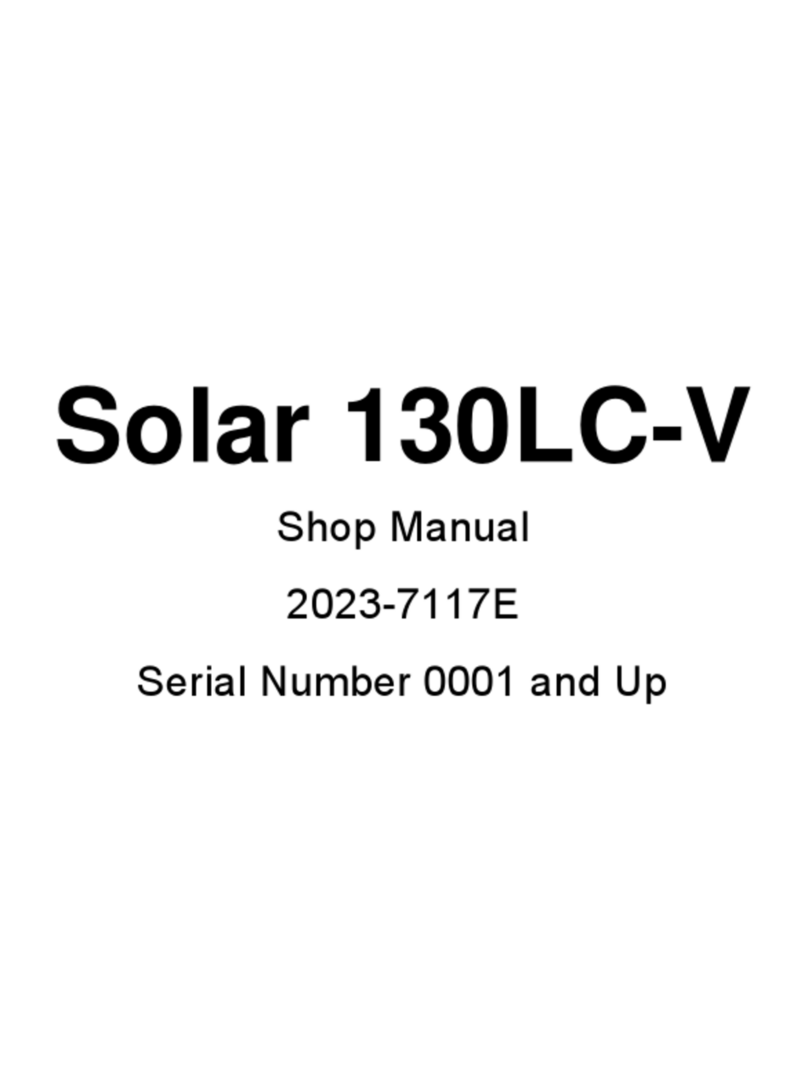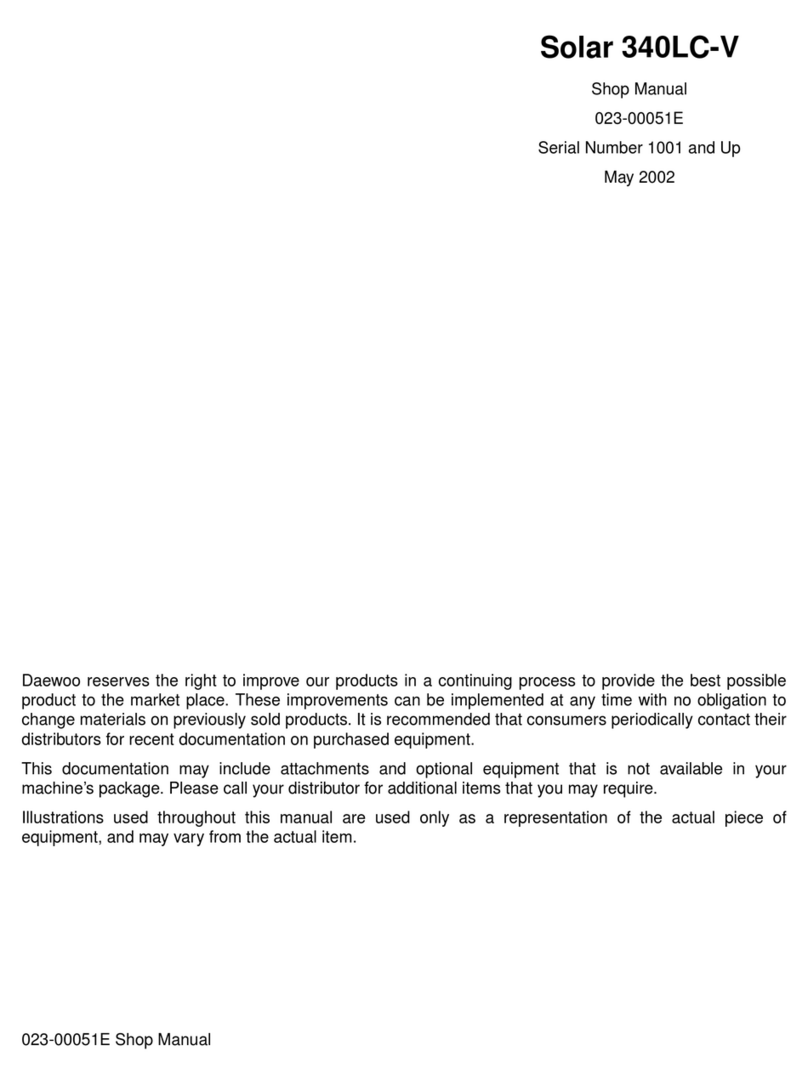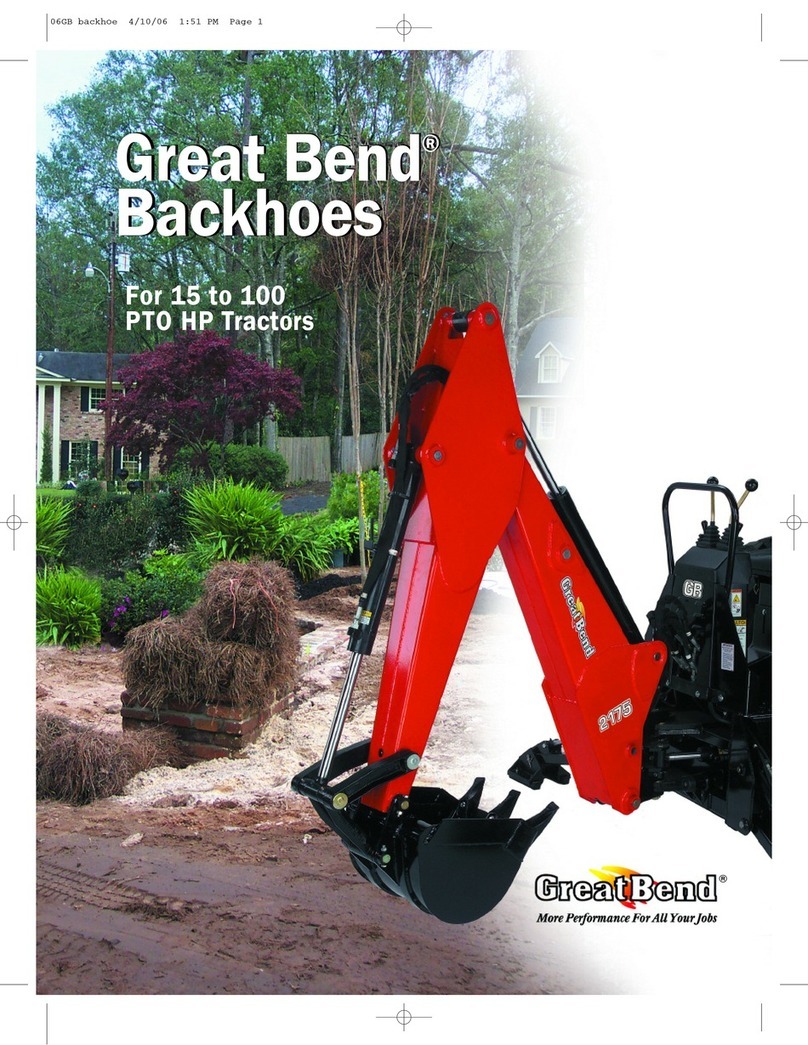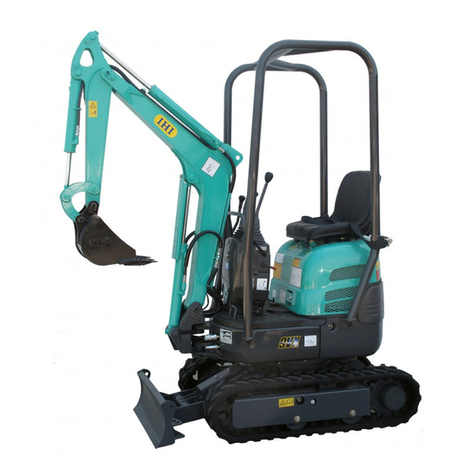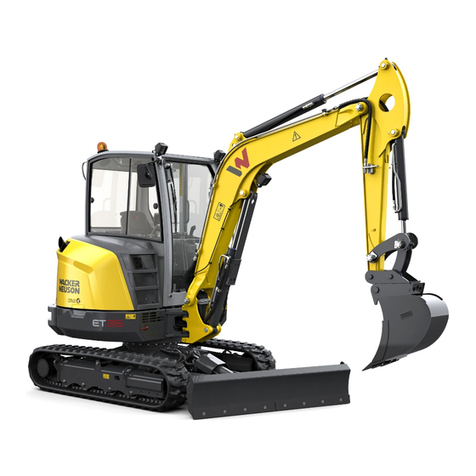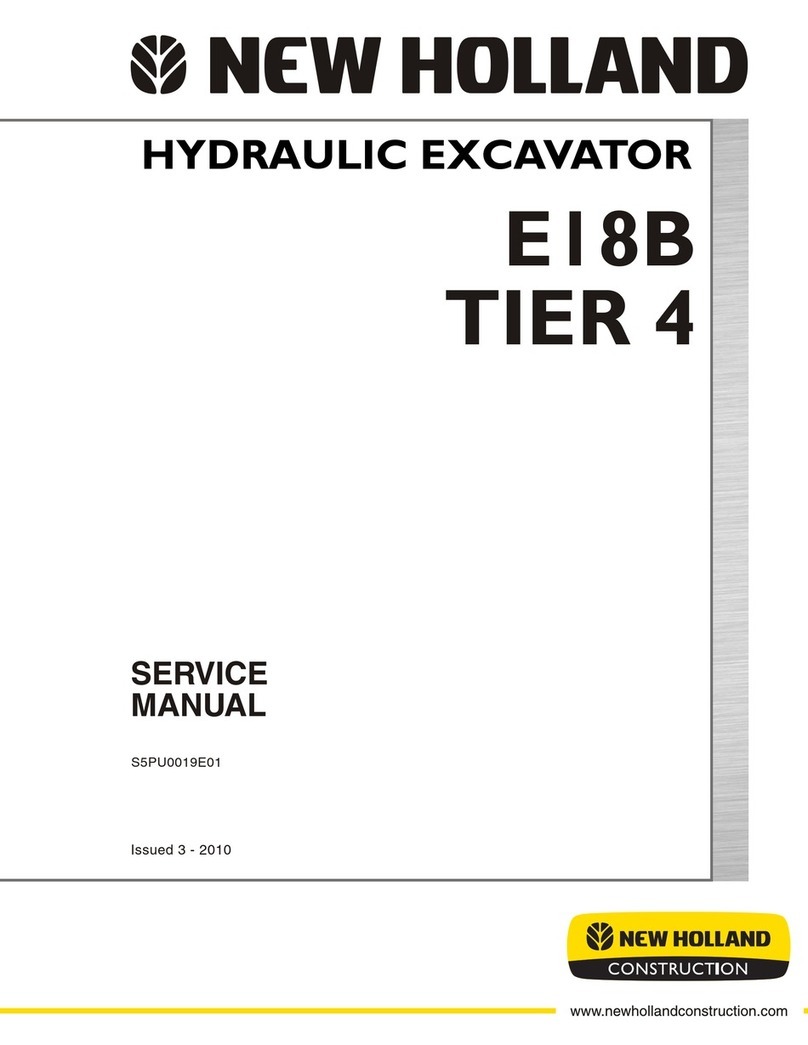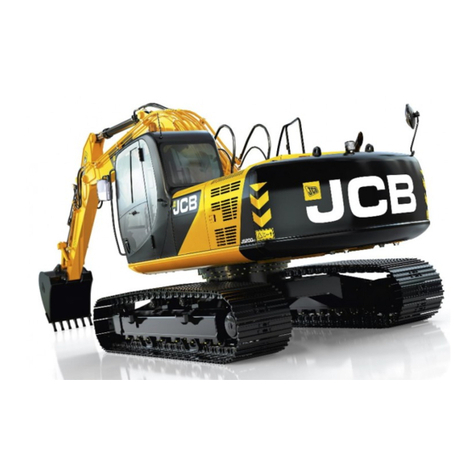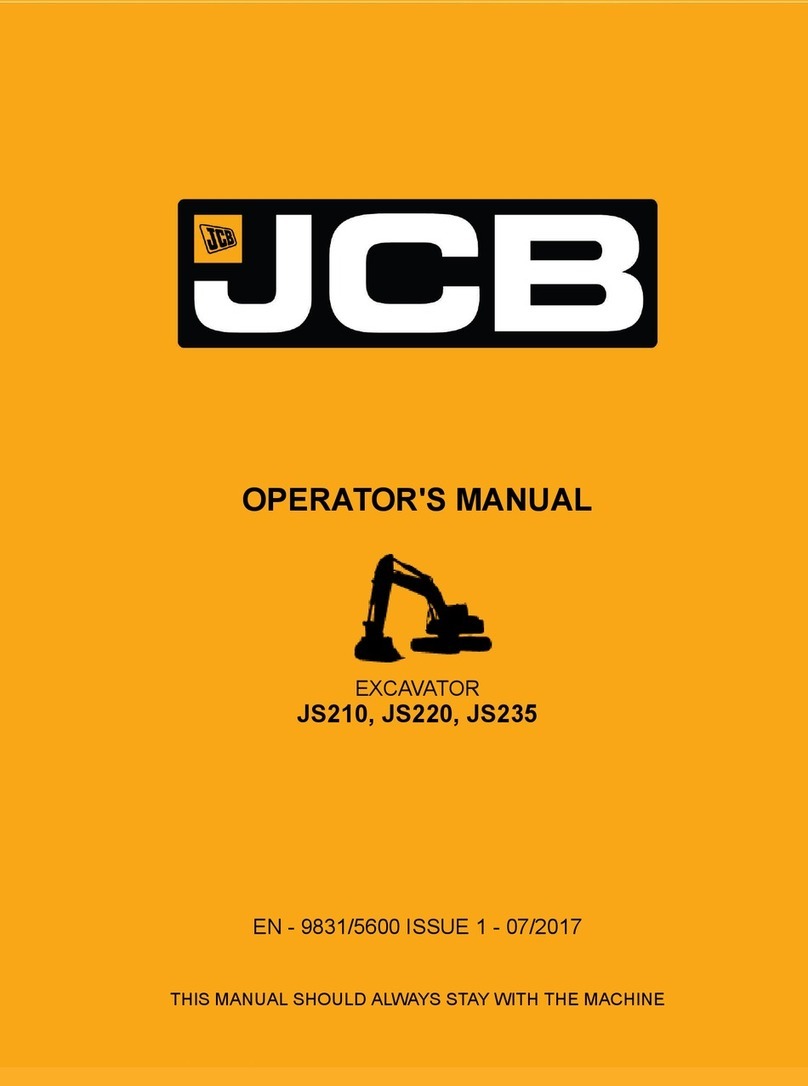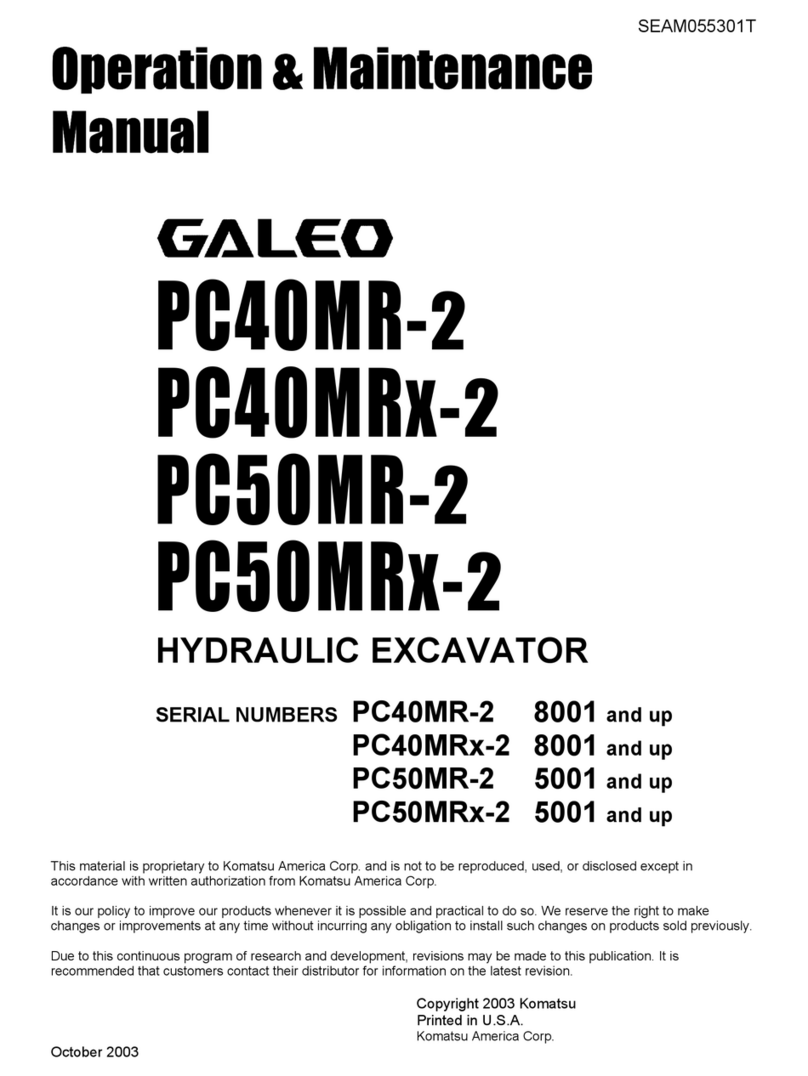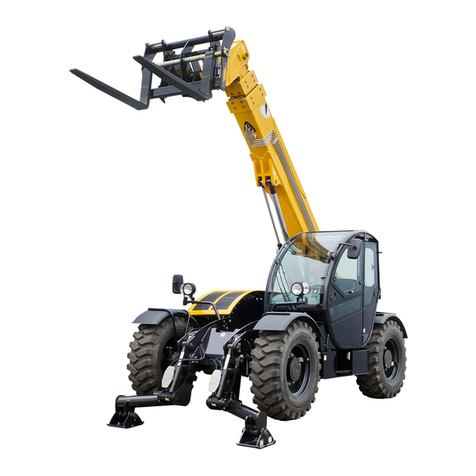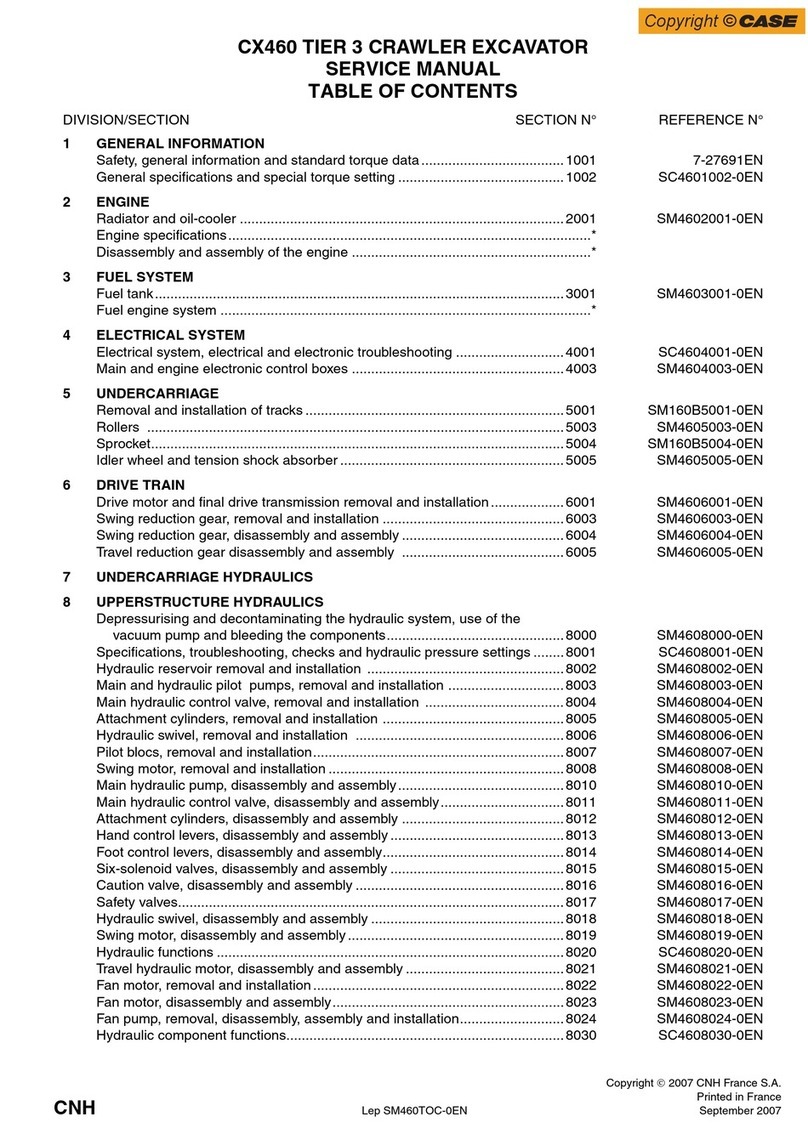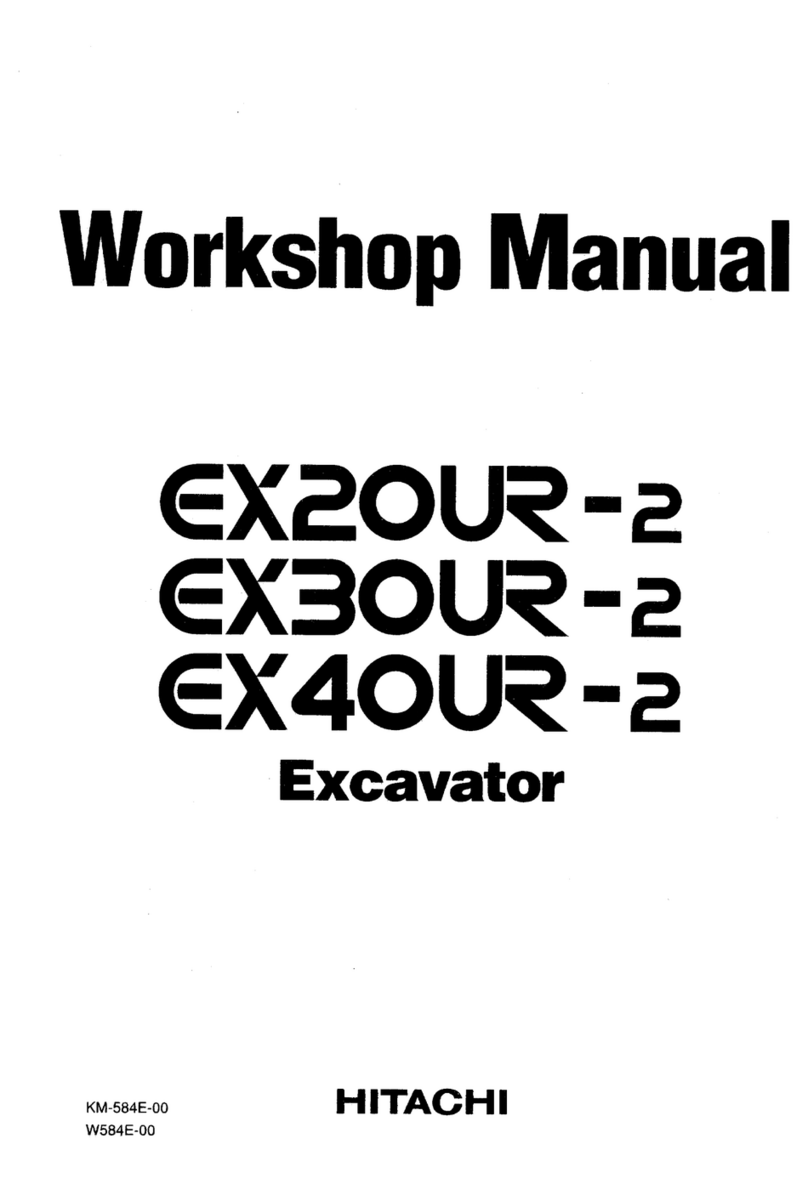Daewoo Solar 200W-V User manual

Shop Manual
2023-7139E
Serial Number 0001 and Up
March 2000
Solar 200W-V

Product Label
Instructions
Trim Out The Label Along
The Lines And Insert Into
Pocket On The Binder Spine
Pub. No. 2023-7139E


Table of Contents
Page I
1TABLE OF CONTENTS
Safety
Wheel Excavator Safety ........................................................................S0102020
Specifications
Specifications for Solar 200W-V ............................................................S0202040
General Maintenance
General Maintenance Procedures.........................................................S0302000
Standard Torques ..................................................................................S0309000
Upper Structure
Cab ........................................................................................................S0402020
Counterweight........................................................................................S0403000
Fuel Tank...............................................................................................S0405070
Swing Bearing........................................................................................S0407010
Swing Reduction Gearbox.....................................................................S0408040
Lower Structure and Chassis
Ram Lock Valve Operation....................................................................S0503000
Engine and Drive Train
Front Axle ..............................................................................................S0602100
Transmission, Final Drive and Rear Axle ..............................................S0602110
Air-Conditioner.......................................................................................S0605010
Drive Coupling (Main Pump)..................................................................S0609000
Hydraulics
Hydraulic System Troubleshooting, Testing and Adjustment ................S0702110
Accumulator...........................................................................................S0703000
Center Joint (Swivel)..............................................................................S0704070

Table of Contents
Page II
Cylinders................................................................................................S0705000
Swing Motor...........................................................................................S0707250
Travel Motor...........................................................................................S0707350
MAin Pump (With Regulator, Steering Pump and Brake Pump) ...........S0708430
Brake Supply Valve ...............................................................................S0709220
Counterbalance Valve ...........................................................................S0709300
Main Control Valve (Toshiba dx28-60) ..................................................S0709440
Remote Control Valve (Work Lever / Joystick) ......................................S0709450
Steering Valve .......................................................................................S0709710
Hydraulic Schematic (Solar 200W-V) ....................................................S0792100
Electrical System
Electrical System ...................................................................................S0802120
Electrical Schematic (Solar 200W-V).....................................................S0892100
Attachments
Boom and Arm.......................................................................................S0902080
Bucket....................................................................................................S0904000

Return to Master Table of Contents
1SAFETY

S0102020
Page 1
Wheel Excavator Safety
Return to Master Table of Contents
S0102020
R1
1WHEEL EXCAVATOR
SAFETY
WHEEL EXCAVATOR SAFETYS0102020
CAUTION!
Follow all safety recommendations and safe shop practices outlined in the front of this manual
or those contained within this section.
Always use tools and equipment that is in good working order.
Use lifting and hoisting equipment capable of safely handling load.
Remember, that ultimately safety is your own personal responsibility.
MODEL SERIAL NUMBER RANGE
Solar 130W-V 0001 and Up
Solar 200W-V 0001 and Up
Copyright 1999 Daewoo
December 1999

S0102020
Page 2
Wheel Excavator Safety
Return to Master Table of Contents
TABLE OF CONTENTS
To the Operator of a Daewoo Excavator......................................................... 3
General Safety Essentials .............................................................................. 5
Location of Safety Labels ............................................................................... 5
Summary of Safety Precautions for Lifting in Digging Mode .......................... 6
Work-site Precautions .................................................................................... 7
Operation........................................................................................................ 9
Equipment .................................................................................................... 14
Maintenance................................................................................................. 18
Shipping and Transportation ........................................................................ 21

S0102020
Page 3
Wheel Excavator Safety
Return to Master Table of Contents
TO THE OPERATOR OF A DAEWOO EXCAVATOR
Please respect the i mportance of taking responsibility for your own sa fety, and that of other people who
may be affected by your actions.
The safety information on the following pages is organized into the following sections:
1. “General Safety Essentials” on page -5
2. “Location of Safety Labels” on page -5
3. “Summary of Safety Precautions for Lifting in Digging Mode” on page -6
4. “Work-site Precautions” on page -7
5. “Operation” on page -9
6. “Equipment” on page -14
7. “Maintenance” on page -18
8. “Shipping and Transportation” on page -21
DANGER!
Unsafe use of the excavator could lead to serious injury or death. Operating procedures,
maintenance and equipment practices or traveling or shipping methods that do not follow the
safety guidelines on the following pages could cause serious, potentially fatal injuries or
extensive damage to the machine or nearby property.

S0102020
Page 4
Wheel Excavator Safety
Return to Master Table of Contents
LEARN THE SIGNAL WORDS USED WITH THE SAFETY ALERT SYMBOL
The words "CAUTION", "WARNING", and "DANGER" used throughout this manual and on decals on the
machine indicate degree of risk of hazards or unsafe practices. All three degrees of risk indicate that safety
is involved. Observe precautions indicated whenever you see the Safety Alert "Triangle," no matter which
signal word appears next to the "Exclamation Point" symbol.
SAFETY ALERT SYMBOL
Be Prepared - Get To Know All Operating and Safety Instructions.
This is the Safety Alert Symbol. Wherever it appears in this manual or on safety signs on the
machine you should be alert to the potential for personal injury or accidents. Always observe
safety precautions and follow recommended procedures.
CAUTION!
Indicates potential of a hazardous situation that, if not avoided, could result in minor or
moderate injury. It may also be used to alert against a generally unsafe practice.
WARNING!
Indicates potential of a hazardous situation that, if not avoided, could result in serious injury or
death. It may also be used to alert against a highly unsafe practice.
DANGER!
Indicates imminent hazard of a situation that, if not avoided, is very likely to cause death or
extremely serious injury. It may also be used to alert against equipment that may explode or
detonate if handled or treated carelessly.

S0102020
Page 5
Wheel Excavator Safety
Return to Master Table of Contents
GENERAL SAFETY ESSENTIALS
ACCESSORY APPLICATIONS
The excavator has been pr imarily designed for moving ear th with a bucket. For use as a grapple or for
other object ha ndling, con tact Dae woo f or pr oper in stallation an d appl ication. Lifting-work applications
(unless restricted or prohibited by lo cal r egulations) ar e permitted i n approved lift configuration, t o rated
capacity only, with no side-loading. DO NOT use the machine for activities for which it was not intended.
DO NOT use the bucket for lifting work, unless lift slings are used in the approved configuration.
Use of an accessory hydraulic hammer (breaker), work in rough terrain, demolition applications or ot her
hazardous operation may require installation of additional protective structures to safeguard the operator.
LIFTING CAPACITY RATING CONFIGURATION
Lifting capacity ratings that are printed at the end of this safety section are based on the machine being
level, on a firm supporting surface, with hooks and slings attached in approved configuration. Loads must
be balanced and su pported e venly. Us e ta glines to k eep the load s teady if wi nd co nditions and la rge
surface area are a p roblem. Work crew hand signals, individual tasks and safe procedures should all be
universally understood before the lift is made.
LOCATION OF SAFETY LABELS
Location of s afety lab els ( decals) can v ary fr om unit to u nit. Ref er to a ppropriate O peration an d
Maintenance Manual, and Parts Manual for your unit.
Always replace damaged or faded decals.
IMPORTANT
Before using the excavator to make lifts check municipal and regional regulations or statutes
that could apply. Governing ordinances may require that all heavy lifting be done with single
purpose equipment specifically designed for making lifts, or other local restrictions may apply.
Making heavy lifts with a general purpose excavator that can be used for digging, loading,
grading or other work may be expressly forbidden by a regional injunction or other legal
prohibition. Always follow all of the other instructions, guidelines and restrictions for Safe
Lifting in the Operation and Maintenance and Shop Manuals.

S0102020
Page 6
Wheel Excavator Safety
Return to Master Table of Contents
SUMMARY OF SAFETY PRECAUTIONS FOR LIFTING
IN DIGGING MODE
To lift safely while in Digging Mode, the following items must be evaluated by the operator and the work-site
crew.
• Condition of ground support
• Excavator configuration and attachments
• Weight, lifting height and lifting radius
• Safe rigging of the load
• Proper handling of the suspended load
Taglines on opposite sides of the load can be very helpful in keeping a suspended load secure, if they are
anchored safely to control points on the ground.
Always engage the "Digging Mode" control on the Instrument Panel before using the excavator for lifting
work.
UNAUTHORIZED MODIFICATIONS
Any modification made without authorization or written approval from Daewoo can create a safety hazard,
for which the machine owner must be held responsible.
For safety’s sake, replace all OEM parts with the correct authorized or genuine Daewoo part. For example,
not taking the time to replace fasteners, bolts or nuts with the correct replacement parts could lead to a
condition in which the safety of critical assemblies is dangerously compromised.
DANGER!
Unsafe use of the excavator while making rated lifts could cause serious, potentially fatal
injuries or extensive damage to the machine or nearby property. Do not let anyone operate the
machine unless they’ve been properly trained and understand the information in the Operation
and Maintenance Manual.
WARNING!
NEVER wrap a tagline around your hands or body.
NEVER rely on taglines or make rated lifts when wind gusts are in excess of 48.3 km/hr (30 mi/h).
Be prepared for any type of wind gust when working with loads that have a large surface area.
WARNING!
If you need more information or have any questions or concerns about safe operating
procedures or working the excavator correctly in a particular application or in the specific
conditions of your individual operating environment, please consult your local Daewoo
representative.

S0102020
Page 7
Wheel Excavator Safety
Return to Master Table of Contents
WORK-SITE PRECAUTIONS
ATTACHMENT PRECAUTIONS
Options ki ts ar e a vailable th rough y our dea ler. C ontact D aewoo f or i nformation on a vailable one- way
(single-acting) and two-way (double-acting) pi ping/valving/auxiliary c ontrol kits. Bec ause Daewoo cannot
anticipate, identify or test all of the attachments that owners may wish to install on their machines, please
contact Daewoo for authorization and approval of attachments, and their compatibility with options kits.
AVOID HIGH-VOLTAGE CABLES
Serious injury or dea th ca n r esult fr om contact
or p roximity to h igh-voltage electric lines. Th e
bucket doe s no t have to mak e physical contact
with power lines for current to be transmitted.
Use a sp otter and hand signals to sta y a way
from power l ines not clearly vi sible t o th e
operator.
Use these minimum distances as a guideline only. Depending upon the voltage in the line and atmospheric
conditions, strong current shocks can occur with the boom or bucket as far away as 4 - 6 m (13 - 20 ft) from
the power line. Very high voltage and rainy weather could further decrease that safety margin.
NOTE:
Before s tarting an y ty pe of operation near po wer li nes ( either above ground or b uried
cable-type), you should always contact the power utility directly and work out a safety plan
with them.
BEFORE STARTING TO DIG, CONTACT AUTHORITIES
Below ground hazards also include natural gas lines, water mains, tunnels and buried foundations. Know
what’s underneath the work-site before starting to dig.
BE AWARE OF HEIGHT OBSTACLES
Any type of object in the vicinity of the boom could represent a potential hazard, or cause the operator to
react suddenly and cause an accident. Use a spotter or signal person working near bridges, phone lines,
work-site scaffolds, or other obstructions.
VOLTAGE MINIMUM SAFE
DISTANCE
6.6kV 3.0 m (9' - 10'')
33.0kV 4.0 m (13' - 1'')
66.0kV 5.0 m (16' - 5'')
154.0kV 8.0 m (26' - 3'')
275.0kV 10.0 m (32' - 10'')
HGB1005L
Figure 1

S0102020
Page 8
Wheel Excavator Safety
Return to Master Table of Contents
USE CARE ON LOOSE SUPPORT
Working heavy loa ds over loo se, s oft gr ound or u neven, broken ter rain can cau se dang erous s ide loa d
conditions and possible tipover and injury. Travel without a load or balanced load may also be hazardous.
If temperatures are changing, be c autious of dark and wet patches when working or traveling over frozen
ground. Sta y a way fr om di tches, o verhangs and al l oth er weak s upport surfaces. Halt w ork and install
support mats or blocking if work is required in an area of poor tire support.
USE SOLID SUPPORT BLOCKING
Never rely on lift jacks or other inadequate supports when work is being done. Block tires fore and aft to
prevent any movement.
OVERHANGS ARE DANGEROUS
Digging the workface under an overhang – the work area beneath a cliff or under the edge of a ditch – is
dangerous. K now the hei ght a nd r each lim its of the e xcavator an d pl an a head whi le wor king. A void
creating dangerous situations by moving around the work-site while making excavations. Go on to another
digging area b efore steep overhangs a re f ormed. Working a round d eep pi ts o r along high walls or
trenching m ay require support b locks, es pecially af ter hea vy r ainfalls or dur ing s pring th aws. Park th e
excavator away from overhangs before work shutdown.
SLOPING TERRAIN REQUIRES CAUTION
Dig e venly a round the wor k-site wh enever
possible, tr ying to gradually le vel any existing
slope. If it’ s not po ssible to le vel the a rea or
avoid working on a slope, reducing the size and
cycling rate of the workload is recommended.
On sl oping su rfaces, us e c aution whe n
positioning the excavator prior to starting a work
cycle. Stay alert for instability situations in order
to avoid getting i nto th em. For e xample, y ou
should alw ays avoid w orking the b ucket o ver
downhill tires when parked perpendicular to th e
slope. Sl ow a ll do wnhill swing mo vements an d
avoid full extensions of the bucket in a downhill
direction. Lifting the bucket too high, too close to
the machine, while the excavator is turned uphill
can also be hazardous.
203mm-304mm
(8"-12")
203mm-304mm
(8"-12")
HAOJ731L
Figure 2

S0102020
Page 9
Wheel Excavator Safety
Return to Master Table of Contents
STAY ALERT FOR PEOPLE MOVING
THROUGH THE WORK AREA
When l oading a tr uck you sh ould al ways k now
where the driver is.
Avoid loading over the cab of a truck even if the
driver is i n a s afe s pot. S omeone e lse could
have go ne i nside, f or an y n umber o f r easons.
Avoid w orking whe re uns een pas sersby m ight
be.
Slow down the work cycle and use slower travel
speeds in congested or populated areas. Use a
commonly un derstood si gnal s o th at oth er
members of the work c rew c an w arn th e
operator t o s low or halt wor k i n a n impending
hazard situation.
BE AWARE OF AND CONFORM TO LOCAL REGULATIONS
Minimum levels of insurance coverage, work permits or certification, physical barriers around the work-site
or restricted hours of operation may be mandated by governing authorities. There may also be guidelines,
standards or r estrictions on equ ipment tha t ma y b e u sed to perform c ertain k inds of w ork. Chec k an d
follow all local requirements, which may also be related to below ground hazards and power lines.
OPERATION
OPERATE WHILE SEATED AT THE
OPERATOR’S STATION ONLY
Never reach in t hrough a wi ndow to work a
control. Do not operate th e e xcavator un less
you’re in the co mmand position, s tay al ert an d
focused on your work a t al l times but DO NOT
twist out of the se at if job activity behind you (or
to the side) requires your attention.
Use a spotter or s ignal per son if you c an’t see
clearly and something is happening behind you.
Replace dam aged safety la bels and lost or
damaged owner’s manuals.
Do no t le t an yone operate the machine un less
they’ve be en fu lly an d co mpletely trained, i n
safety and in the operation of the machine.
HGB1013L
Figure 3
HAOA150L
Figure 4

S0102020
Page 10
Wheel Excavator Safety
Return to Master Table of Contents
BEFORE STARTING THE ENGINE
Do a "pre-start" safety check:
• Walk a round your ma chine before ge tting i n t he o perator’s c ab. Loo k for evidence o f l eaking
fluid, lo ose f asteners, mi saligned a ssemblies or any other indications o f po ssible eq uipment
hazard.
• All equipment covers and machinery safety guards must be in place, to protect against injury
while the machine is being operated.
• Look around the work-site area for potential hazards, or people or property that could be at risk
while operation is in progress.
• NEVER s tart the eng ine i f the re is an y i ndication th at m aintenance o r service wor k is i n
progress, or if a warning tag is attached to controls in the cab.
• A machine that has not been used recently, or is being operated in extremely cold temperatures,
could require a warm-up or maintenance service prior to start-up.
• Check gauges and monitor displays for normal operation prior to starting the engine. Listen for
unusual noises and remain alert for othe r pote ntially haz ardous conditions at the start of th e
work cycle.
NEVER USE ETHER STARTING AIDS
An electric-grid type manifold heater is used for
cold starting. The glowing hea ter ele ment ca n
cause ethe r or othe r s tarting flu id to de tonate,
causing injury.
MOUNTING AND DISMOUNTING
NEVER get on or off a moving machine. Do not
jump on /off. The en try/egress pa th s hould b e
clear of mud, oil and spi lls and m ounting
hardware must be kept tight and secure.
Always use handholds and st eps, and maintain
at least 3-point contact of hands and feet. Never
use controls as handholds.
NEVER get up from the operator’s seat or leave
the operator’s station and dismount the machine
if the engine is running.
Figure 5
Figure 6

S0102020
Page 11
Wheel Excavator Safety
Return to Master Table of Contents
OBSERVE GENERAL SAFETY RULES
Only trained and authorized personnel, with a good knowledge and awareness of safe procedures, may be
allowed to operate or perform maintenance or service on the excavator.
All personnel a t t he work-site should be a ware of assigned individual r esponsibilities a nd tasks.
Communication and hand signals used should be understood by everyone.
Terrain and soil conditions at the job site, approaching traffic, weather-related hazards and any above or
below ground obstacles or hazards should be observed and monitored by all work crew members.
ENGINE VENTILATION
Engine exhaust ga ses ca n ca use f atal
accidents, as w ell as un consciousness, lo ss o f
alertness, judgement an d m otor control an d
serious injury.
Make sure of a dequate ventilation bef ore
starting the engine in any enclosed area.
You s hould also be a ware of open wi ndows,
doors or duc twork in to whi ch e xhaust ma y b e
carried, or blown by the wind, exposing others to
danger.
ASBESTOS DUST HAZARD PREVENTION
Asbestos dust can be HAZARDOUS to your health if it is inhaled.
If you handle materials containing asbestos fibers, follow these guidelines as given below:
• Never use compressed air for cleaning
• Use water for cleaning to keep down the dust.
• Work on the machine or component with the wind at your back whenever possible.
• Use an approved respirator, with proper filtration cartridges.
TAKE TIME TO PROVIDE GOOD VISIBILITY
Halt work if visibility is poor. Strong rains, snow, fog and extremely dusty conditions can all obscure visibility
so badly that it is best to wait for weather to change or dust to settle before continuing operation.
Night work in areas of limited visibility should be halted if installation of extra work lights on the machine (or
work area) is necessary.
Keep dirt and dust off of windows and off the lens surfaces of work lights. Stop working if lights, windows or
mirrors need cleaning or adjustment.
,,,
,,,
HAOA070L
Figure 7

S0102020
Page 12
Wheel Excavator Safety
Return to Master Table of Contents
FUEL, OIL AND HYDRAULIC FLUID FIRE
HAZARDS
Add fuel, oil, antifreeze and hydraulic fluid to the
machine only in a w ell v entilated ar ea. The
machine m ust be p arked with controls, l ights
and s witches tu rned o ff. The engine mus t b e
"OFF" and a ny f lames, g lowing e mbers,
auxiliary hea ting uni ts or s park-causing
equipment must be do used, t urned " OFF" and/
or kept well clear of the machine.
Static electricity can produce dangerous sparks
at the fuel fi lling nozzle. In very co ld, dry
weather or oth er conditions th at c ould pr oduce
static discharge, keep the tip of the fuel nozzle
in c onstant contact with th e neck o f th e fuel
filling nozzle, to provide a ground.
Keep fuel and other fluid reservoir caps tight and
do not start the eng ine until caps ha ve bee n
secured.
BOOST STARTING OR CHARGING ENGINE
BATTERIES
Turn " OFF" a ll el ectrical e quipment before
connecting leads to the ba ttery. This includes
electrical s witches on t he b attery c harger or
boost starting equipment.
When boost-starting fr om an other mac hine or
vehicle do not allow the two machines to touch.
Wear s afety glasses or g oggles w hile r equired
parallel b attery co nnections – p ositive t o
positive and negative to negative – are made.
24 v olt battery units co nsisting of tw o se ries-
connected tw elve v olt batt eries ha ve a ca ble
connecting one po sitive te rminal o n on e o f th e
12 volt batteries to a negative terminal on the other battery. Booster or charger cable connections must be
made between th e n on-series-connected p ositive terminals and be tween the negative terminal of th e
booster battery and the metal frame of the machine being boosted or charged. Refer to the procedure and
illustration in “Starting Engine Using A Booster Battery” on page 3-8 of this manual.
Connect positive cable first when installing cables and disconnect the negative cable first when removing
them. The final cable connection, at the metal frame of the machine being charged or boost-started, should
be as far away from the batteries as possible.
HAOA120L
Figure 8
HAOA310L
Figure 9

S0102020
Page 13
Wheel Excavator Safety
Return to Master Table of Contents
TRAVEL CONTROLS MAY PRODUCE REVERSED OPERATIONS
Before starting the machine you should always check to see which end of the lower structure is under the
operator’s cab. In the normal travel configuration, the steering axle is at t he front of the machine, and the
rigid axle is under the engine and counterweight. If the operator swings the cab 180°, the rigid axle will be
underneath the operator’s cab, and steering will be reversed.
When traveling the excavator always keep lights on; make sure that you a re in compliance with al l state
and local regulations concerning warning flags and signs and keep the operator’s cab positioned over the
front end of lower structure. That will keep travel controls in their intended configuration and at the same
time, maintain the proper orientation of lights on the machine and posted flags and signs.
KEEP "PINCH POINT" AREAS CLEAR - USE
CAUTION IN REVERSE & SWING
Use a s ignal pe rson i n h igh tr affic ar eas and
whenever the operator’s view i s not clear, such
as when traveling in reverse. Make sure that no
one comes inside the s wing r adius of th e
machine.
Anyone s tanding nea r th e l ower str ucture, or
working assemblies of the attachment, is at r isk
of be ing caught be tween mo ving parts of th e
machine.
Never al low anyone to ride o n a ny part o f th e
machine or attachment, including any part of the
turntable or operator’s cab.
TRAVEL PRECAUTIONS
Attachment control levers should not be operated while traveling.
Do not change selected travel mode (FAST/SLOW) while traveling.
Fold in work equipment so that the outer end of the boom is as close to the machine as possible, and is
203 mm – 304 mm (8" – 12") above ground.
Never travel over obstacles or slopes that will cause the machine to tilt severely. Travel around any slope or
obstacle that causes 10 degrees tilt, or more.
OPERATE CAREFULLY ON SNOW AND ICE AND IN VERY COLD TEMPERATURES
In i cy c old w eather a void su dden tr avel movements a nd stay away fr om e ven v ery s light sl opes. Th e
machine could skid off to one side very easily.
Snow accumulation could hide or obscure potential hazards. Use care while operating or while using the
machine to clear snow.
Warming up the engine for a short period may be necessary, to avoid operating with sluggish or reduced
working c apacity. The j olting shocks and i mpact loads c aused b y bumping or bott oming th e boo m or
attachment are more likely to cause severe stress in very cold temperatures. Reducing work cycle rate and
work load may be necessary.
HGB1014L
Figure 10

S0102020
Page 14
Wheel Excavator Safety
Return to Master Table of Contents
PARKING THE MACHINE
Avoid making sudden stops, or parking the machine wherever it happens to be at the end of the work day.
Plan ahead so that the excavator will be on a firm, level surface away from traffic and away from high walls,
cliff edge s a nd any ar ea of potential w ater ac cumulation or runoff. If pa rking on in clines is unavoidable,
block the tires t o p revent mo vement. Lower th e b ucket o r other w orking attachment c ompletely t o th e
ground, or to a n o vernight su pport s addle. The re sh ould be no po ssibility of un intended or ac cidental
movement.
SHUTDOWN CONTROL FUNCTIONS
After the mac hine h as bee n l owered to the o vernight s torage pos ition and al l s witches and ope rating
controls are in the "OFF" position, the control stand lock lever must be engaged. Release the left console
to disable all pilot circuit control functions.
Insert th e swing l ock pin and en gage al l brakes and l ock-down se curity e quipment t hat may h ave been
installed on the machine.
EQUIPMENT
ROUGH OPERATION MAY REQUIRE USE OF
CERTIFIED SAFETY EQUIPMENT
Working in mines, tunnels, deep pits or on loose
or wet surfaces could produce danger of falling
rock o r hazardous fly ing o bjects. A dditional
protection f or t he o perator’s c ab co uld b e
required in the form of a FO G / F alling O bject
Guard or windows guards.
IMPORTANT
When hydraulic system maintenance or service work must be performed, you should be aware
that an accumulator in the system stores fluid under pressure after system lock down, even after
the control stand is raised. Release this energy by working controls with the engine "OFF," until
pressure in the pilot circuit has been completely bled away.
HAOA110L
Figure 11
Table of contents
Other Daewoo Excavator manuals



